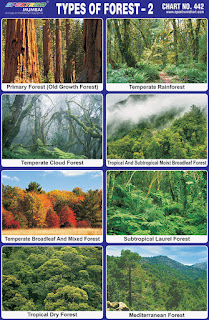 |
| Types of Forest 2 Chart |
Spectrum Chart - 442 : Types of Forest 2
1. Primary Forest (Old Growth Forest) - An
old growth forest also termed primary forest is a forest that has
attained great age without significant disturbance and thereby
exhibits unique ecological features and might be classified as a
climax community. Old-growth forests tend to have large trees and
standing dead trees, multi-layered canopies with gaps that result
from the deaths of individual trees and coarse woody debris on the
forest floor.
2. Temperate Rainforest - Temperate
rainforests are coniferous or broadleaf forests that occur in the
temperate zone and receive heavy rainfall. These forests can be found
in temperate regions of North America, South America, Europe, East
Asia, Australia and New Zealand. Generally these forests exist where
the climate is affected by warm ocean currents. The largest temperate
rainforests in the world are located in North America.
3. Temperate Cloud Forest - Cloud forests
are like rain forests in that they generally receive high levels of
precipitation. The difference is that with cloud forests, much of
that precipitation comes directly from the clouds that filer through
the trees.
4. Tropical & Subtropical Moist
Broadleaf Forest - Tropical and subtropical moist broadleaf forests
are a tropical and subtropical forest biome, sometimes referred to as
jungle.
5. Temperate Broadleaf & Mixed Forest
- Temperate broadleaf and mixed forest is a temperate climate
terrestrial biome, with broadleaf tree eco regions and with conifer
and broadleaf tree mixed coniferous forest eco regions. Temperate
broadleaf and mixed forests occur in areas with distinct warm and
cool season. These forests occur in relatively warm and rainy
climates, sometimes also with a distinct dry season.
6. Subtropical Laurel Forest - Laurel
forest is a type of subtropical forest found in areas with high
humidity and relatively stable, mild temperatures. The forest is
characterised by broadleaf tree species with evergreen, glossy and
elongated leaves, known as "laurophyll" or "lauroid".
7. Tropical Dry Forest - Tropical dry
forest is located at tropical and subtropical latitudes. Though these
forests occur in climates that are warm year-round, and may receive
several hundred centimetres of rain per year, they have long dry
seasons which last several months and vary with geographic location.
These seasonal droughts have great impact on all living things in the
forest. They are home to a wide variety of wildlife including
monkeys, deer, large cats, parrots, various rodents and ground
dwelling birds.
8. Mediterranean Forest - Mediterranean
forests are characterised by dry summers and rainy winters. Summers
are typically hot in low-lying inland locations but can be cool near
colder seas. Vegetation types range from forests to woodlands,
savannas, shrublands and grasslands "mosaic habitat"
landscapes are common, where differing vegetation types are
interleaved with one another in complex patterns created by
variations in soil, topography, exposure to wind and sun and fire
history.

No comments:
Post a Comment